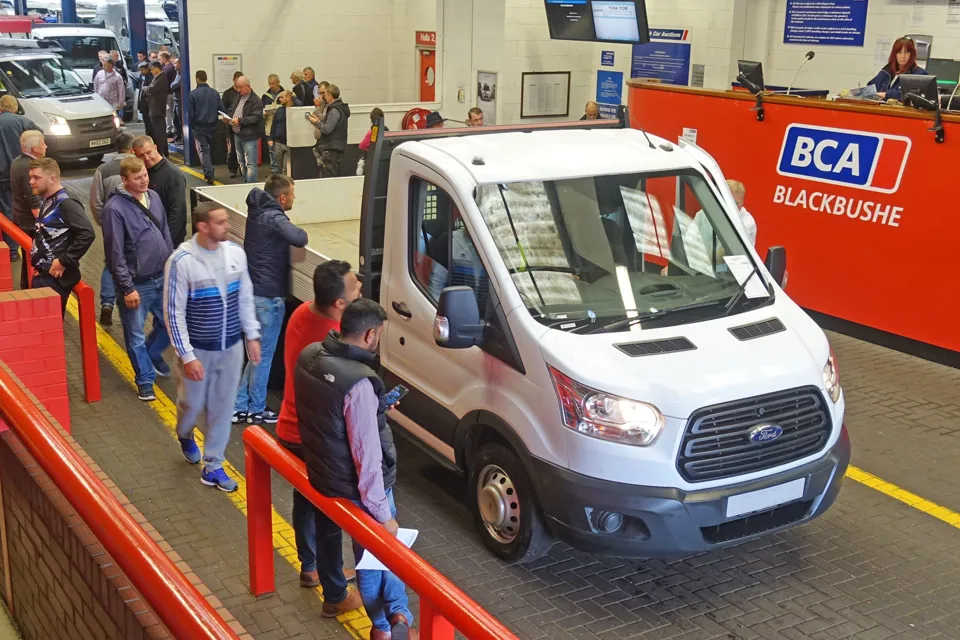Deliberately opting for extras on vans with an eye to boosting their second-hand value can pay dividends. Yet it is a policy that fleets do not always pursue when making acquisitions.
“It doesn’t come into the conversation,” says Activa Contracts remarketing manager Martin Hughes.
Venson Automotive Solutions marketing director Alison Bell adds: “Their decision is driven primarily by what they need the vehicles for and whether they are fit for purpose, rather than specifying them with the resale value in mind. Other considerations include how good a manufacturer’s dealer network coverage is, and whether there are a lot of warranty and maintenance issues associated with its products.”
James Davis, customer strategy and insight director for commercial vehicles at automotive services organisation and auctioneer Cox Automotive, says: “Fleets mainly look at the transaction price and the level of support they’re getting from the manufacturer concerned.”
However, additional features that add to safety and comfort can help a fleet discharge its duty of care to its drivers, says Davis, as well ensuring better residual values (RVs); and healthier residuals can help drive down regular payments if vehicles are acquired on contract hire.
“Reversing cameras and sensors make a van safer and can reduce the amount of accident damage it suffers as well as adding to its desirability second-hand,” he says.
If it suffers less accident damage while in fleet service then repair costs will fall, and RVs should improve.
Although used buyers may find safety devices appealing, that is not to say they will pay extra for them. “They’d rather have heated seats and air conditioning than side airbags,” says Hughes.

Shoreham Vehicle Auctions managing director Alex Wright (pictured) says: “Air conditioning is starting to have a positive impact second-hand and is becoming the norm.”
A study conducted by BCA last year revealed that air-conditioning added well in excess of £1,000 on average to the price realised by used light commercial vans (LCVs).
“A van such a Renault Trafic with air-con, sat-nav and finished in an appealing colour can make bundles,” says Wright. He has known Trafics factory-finished in lime green fetch £1,000 more than those in more common tones.
“They’re all things the small business buyer is looking for,” he remarks.
His comments apply to younger stock, he stresses. “Once a vehicle is five or six years old and has covered 100,000 miles or more then small business buyers are not worried about the specification,” he says. “They just want something that will do a job of work.”
Used van buyers may like to see cruise control, but may not be so interested in sat-nav, says Davis. “A lot of people have got smartphones and use Google Maps instead,” he says.
Hughes stresses: “A van must have Bluetooth though. If it hasn’t, you’ve got a big problem.”
Automatic and automated manual boxes have a definite appeal.
A Volkswagen Caddy or Transporter with a dual-clutch DSG (direct shift gearbox) transmission has a massive advantage over one with a manual box, says Wright. “They’re like gold dust,” he comments.
Says Davis: “I’ve known cases where a DSG box has added more to a van’s price than the option costs new.”
 Geoff Flood, commercial vehicle sales manager at auctioneer Aston Barclay, sounds a note of caution, however. “The presence of an auto box can mean that a van will fetch £700 less than a manual if it is high-mileage and several years old,” he comments.
Geoff Flood, commercial vehicle sales manager at auctioneer Aston Barclay, sounds a note of caution, however. “The presence of an auto box can mean that a van will fetch £700 less than a manual if it is high-mileage and several years old,” he comments.
Potential buyers may fear hefty repair bills if the box goes wrong.
“If it is newer and low-mileage though then it may attract a premium price,” Flood adds.
More power than the fleet operator may need can play well in the second-hand sector, but has to be balanced against the potential risk of more fuel consumption, accidents and speeding tickets for the fleet’s drivers.
Aston Barclay has an auction site in Leeds, among other locations. Flood says: “We find that in a hilly area like West Yorkshire, used buyers want the 140hp rather than a 102hp Transporter.”
Perhaps surprisingly, Citroën Berlingos with three-seater cabs are extraordinarily popular second-hand, says Flood, despite the limited elbow room for the centre passenger. They appeal to customers who use their vans for personal transport in the evenings and at weekends.
“They can accommodate a child as well as the driver and spouse,” he points out. The ability to use them as family transport as well as for business purposes means crew vans, with a second row of seats plus a load area at the back, have a ready audience among used buyers too.
Even the type of doors fitted can make a difference to a van’s second-hand desirability. Hatch- or tailgate-type back doors rather than twin rear doors can be more appealing on certain medium-size panel vans because it’s easier to convert them into campers.
Hughes says: “A Vivaro with a tailgate can make up to £500 more than one with twin doors.”
As group fleet manager at Auto Windscreens Shaun Atton understands that opting for cheaper, entry-level vehicles does not necessarily translate into lower leasing costs. The bulk of his firm’s 310-strong all-Ford van fleet is made up of Transit Customs and he is upgrading one rung, from entry-level Leader trim to Trend.
As a consequence, Auto Windscreens drivers will benefit from safety-related features such as front and rear parking sensors and front fog lights. Atton additionally specifies its Customs with adaptive cruise control plus air-con.
The safety systems specified mean the vans sustain less damage – good news from the RV viewpoint – and are at less risk of being involved in an accident.
“We’re meeting our duty of care, we’ve got a happier workforce and we’re getting a better leasing rate,” Atton comments.
Obtained through three lessors – CVM, Arnold Clark-owned Activa, and Rivervale – the Customs stay in service for three years and each cover around 30,000 miles annually.
A question of presentation
How should an ex-fleet LCVs be presented to prospective purchasers?
Any business or personal data that the vehicle may hold must be deleted prior to disposal and the spare ignition key plus the keys for any extra locks that may have been fitted must be available. “Having all the keys present is a real must,” Wright says.
A full service history adds to the van’s used credibility and should be accompanied by the V5C logbook and MOT certificates, if applicable.
“You should certainly ensure the van is given a good clean, inside and out, and the livery is removed,” Wright continues. The fleet’s name, address, logo and so on should all be stripped off, and a cutting compound and plenty of elbow grease should be used to remove any tell-tale outlines they may have left behind.
“The vehicle has to look presentable,” he says.
This is especially the case given that auctions have increasingly enabled buyers to bid online in recent years. Online gives purchasers more time to peruse photographs of a vehicle from all angles before they decide whether to bid or not.
Stuart Pearson, BCA’s chief operating officer, UK remarketing, says: “With increasing volumes of vehicles being sold digitally, presentation is important for online buyers in combination with high-quality imaging and accurate appraisals.”
Vendors who use auctions do so because the process is transparent, there is no comeback from the buyer and they can expect to see their money quickly.
What they receive, however, is the trade rather than the retail price, and there is likely to be a difference of several hundred pounds.
Some operators sell their vehicles themselves – always an option if they have been bought outright – which, potentially, allows them to achieve a price closer to retail. On the downside, however, it is time-consuming, the van is likely to take longer to sell than at auction, a warranty may have to be provided and complaints and demands for compensation may ensue if buyers have problems with their purchases.
Outright purchase can be accompanied by a buy-back deal under which the manufacturer agrees to buy the vehicles at a pre-agreed price at a future date. An open buy-back deal gives the fleet the option of selling the vans itself if it reckons it can get a better price than the manufacturer’s buy-back figure – worth considering.
If a van has been vinyl-wrapped, the wrap should be removed, Pearson says – hopefully revealing pristine paintwork underneath – and BCA can deploy a variety of smart repair techniques to deal with damage to paint and trim.
Really extensive refurbishment is unlikely to yield a return on the expenditure required unless the van happens to be late year, low mileage and with a high specification.
“Have a bonnet re-sprayed to get rid of a few stone chips and prospective buyers may think you’re trying to disguise a major front-end shunt,” remarks Steven Botfield, senior commercial vehicles editor at Cap HPI.
Flood says that “92% of all the vans we sell are not refurbished and are, instead, sold ‘as seen’. Auction bidders prefer to see them in the raw”.
Replacing the load area’s ply lining may be worth considering, though. “Some buyers may be suspicious than you’re trying to hide something, but they also know that if it’s badly-stained with old oil for example then they’ll have to change it anyway,” Hughes observes.
Damage and excessive wear and tear due to driver abuse are likely to be minimised, and residuals enhanced accordingly, if fleets monitor their LCVs closely while in service.
That is likely to involve installing a tracking package with driver behaviour telematics to pick up instances of speeding and harsh acceleration; issues that can be raised with
the individual concerned with an eye to implementing a driver training programme.
An incentive scheme that rewards drivers with zero own-fault accident damage can be beneficial too, suggests Hughes.
Adherence to manufacturer maintenance schedules is vital, but long service intervals mean that interim checks are likely to be necessary to ensure the van’s condition is not allowed to deteriorate. “Many LCV fleets utilise mid-life inspections to identify any issues before they become expensive to repair,” says Pearson.
 Hitachi Capital Vehicle Solutions managing director Jon Lawes says: “Effective maintenance procedures are key to protecting a van’s RV. So, to help fleet managers and drivers stay on top of maintenance, we operate a driver app and booking portal.
Hitachi Capital Vehicle Solutions managing director Jon Lawes says: “Effective maintenance procedures are key to protecting a van’s RV. So, to help fleet managers and drivers stay on top of maintenance, we operate a driver app and booking portal.
“Our advice to drivers is to conduct regular checks and quickly report any instances of damage so they don’t turn into more serious issues further down the line.”
If drivers who work from home have to attend periodic meetings at head office or regional centres then ensure they bring their vans with them, Hughes advises.
“Then audit their vehicles, if necessary using an independent third party, while the meeting takes place,” he says. “If they know their vans are going to be inspected every few months that will ensure they look after them, and that issues such as bumper damage are reported and dealt with.”
A fleet should avoid disposing of a large quantity of vans with an identical spec at one go, says Botfield. Doing so will depress the price.
“It makes far more sense to follow a policy of phased de-fleeting and drip-feed them into the market,” he observes.
Demand for used vans will rise
Wright is confident the second-hand van market will come back strongly post-lockdown as the economy gets moving and SMEs try to catch up with a backlog of orders.
“It looks as though the big infrastructure projects will begin to get underway again and the demand for used vans will rise as sub-contractors return to work,” he says. “Ex-lease stock will start to come back into the market in late summer at a time when SMEs will be looking to replace existing vehicles, or acquire more.
Wright suggests that this all bodes well for a stronger market in quarters three and four.
Flood adds: “We could find it’s red-hot.”

















Login to comment
Comments
No comments have been made yet.